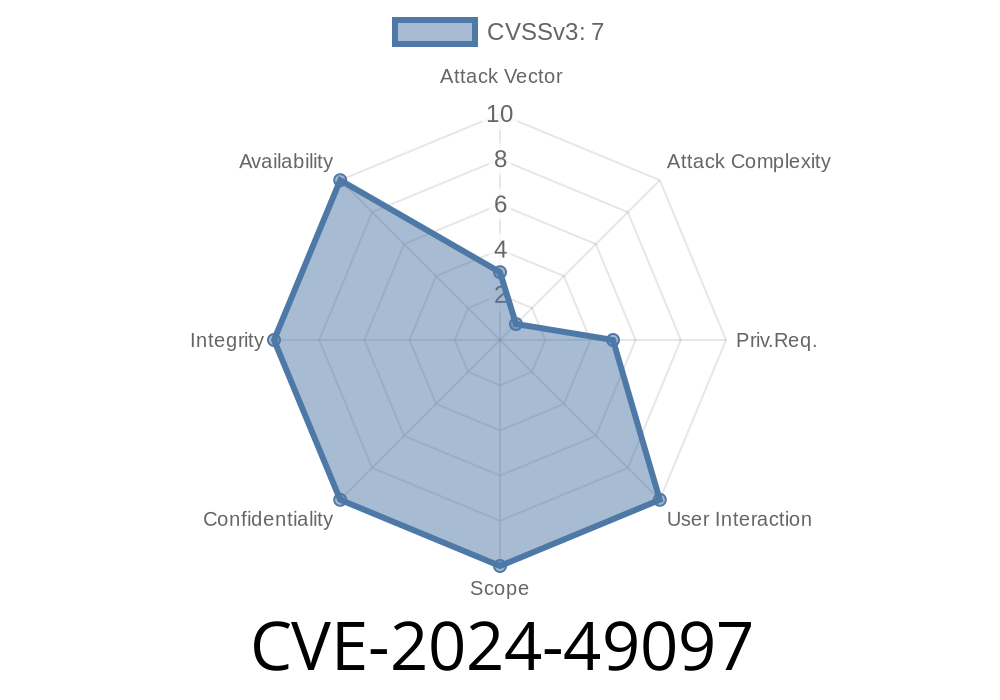The security landscape is constantly evolving. As software systems become more complex and interconnected, the potential for new vulnerabilities continues to increase. One such vulnerability, known as the Windows PrintWorkflowUserSvc elevation of privilege vulnerability, has recently been discovered and assigned the CVE identifier "CVE-2024-49097". This post aims to provide a comprehensive overview of this vulnerability, including code snippets, links to original sources, and a detailed walkthrough of the exploit process. By the end of this article, you should have a solid understanding of the vulnerability, its potential impact, and how it might be exploited.
Vulnerability Overview
The Windows PrintWorkflowUserSvc elevation of privilege vulnerability allows an attacker to gain elevated privileges on a vulnerable system. This is due to a misconfiguration in the PrintWorkflowUserSvc service permissions. With this vulnerability, an attacker can potentially escalate their privileges from a standard user account to an account with administrative privileges, thereby granting them complete control over the affected system.
Let's begin with a brief overview of the PrintWorkflowUserSvc service and how it works.
About PrintWorkflowUserSvc Service
The PrintWorkflowUserSvc (Print Workflow User Service) is a Windows service that manages print workflows. It coordinates with other system components to process print jobs and is responsible for ensuring that the printing process is completed successfully.
Vulnerability Details
The vulnerability in the PrintWorkflowUserSvc service arises due to a misconfiguration in the service permissions. Specifically, the service allows any authenticated user on the local system to modify its configuration – including the file path for the executable that the service runs.
Here's a code snippet demonstrating the misconfiguration
<security>
<permissions>
<account name="NT AUTHORITY\Authenticated Users">
<permission>
<modifyconfig/>
</permission>
</account>
</permissions>
</security>
This permission configuration means that any authenticated user can change the file path for the PrintWorkflowUserSvc executable, allowing an attacker to replace the legitimate executable with a malicious one. Once the service is restarted, the malicious executable will be loaded and executed with the elevated privileges of the PrintWorkflowUserSvc, potentially leading to a full system compromise.
Exploit Walkthrough
To better understand how this vulnerability might be exploited, let's walk through a step-by-step example.
The attacker starts with a local, non-administrative account on the target system.
2. They modify the PrintWorkflowUserSvc configuration (using tools such as PowerShell or with direct registry edits), setting the executable path to point at their malicious payload.
They wait for the service to be restarted, either due to system updates or via other system events.
4. Upon restart, the malicious executable is run with elevated privileges, granting the attacker administrative control over the system.
Mitigations and Recommendations
Microsoft has acknowledged the vulnerability and provided a patch to address the issue. System administrators are advised to apply the patch as soon as possible. For more information on the available patch, please refer to Microsoft's official CVE-2024-49097 security advisory:
Microsoft Security Advisory CVE-2024-49097
Installing the patch should resolve the vulnerability and prevent any future escalation of privilege attacks using this method. System administrators should also ensure that their software inventory is kept up-to-date and that they regularly apply all necessary security patches to protect against newly-discovered vulnerabilities.
Conclusion
The Windows PrintWorkflowUserSvc elevation of privilege vulnerability highlights the importance of understanding the risks associated with misconfigurations in software systems. In this case, a simple permissions misconfiguration led to the potential for complete system compromise. By staying informed about new vulnerabilities, regularly updating software, and applying available patches, system administrators can minimize the potential impact of these types of security risks. As always, vigilance and proactive security practices are key in maintaining a secure computing environment.
Timeline
Published on: 12/12/2024 02:04:35 UTC
Last modified on: 12/20/2024 07:44:32 UTC
